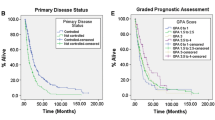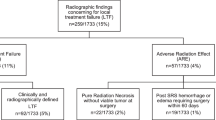Abstract
Although brain metastases are one of the most frequently diagnosed sequelae of systemic malignancy, their optimal management still is not well defined. In that respect, the different diagnostic and therapeutic approaches of BMs patients is an issue for serious discussions. The treatment options include surgical excision, WBRT, radiosurgery, chemotherapy, immunotherapy, etc. Nowadays, the aforementioned treatment modalities are usually combined in different treatment schemes. More than one option is used for the same patient and combining these treatment modalities gives better results than when separately use them. The value of surgical excision of progressing brain metastases treated with gamma knife surgery (GKS) is not well investigated.With the present study, we aim to investigate the value of surgical excision of symptomatic brain lesions that have been previously treated with GKS.



Similar content being viewed by others
References
Al-Shamy G, Sawaya R (2009) Management of brain metastases: the indispensable role of surgery. J Neurooncol 92:275–282
Bindal RK, Sawaya R (1993) Surgical treatment of multiple brain metastases. J Neurosurg 79:210–216
Barker FG (2004) Craniotomy for the resection of metastatic tumors in the US, 1988-2000: decreasing mortality and the effect of provider caseload. Cancer 100:999–1007
Bartumeus F, Clavel P (2000) Surgical treatment of brain metastases. Rev Neurol 31(12):1247–1249
Chan Y, Yeung DKW, Leung S, Cao G (1999) Proton magnetic resonance spectroscopy of late delayed radiation-induced injury of the brain. J Magn Reson Imaging 10:130–137
Coia LR, Aaronson N, Linggood R, Loeffer J, Priestman TJ (1992) A report of the consensus workshop panel on the treatment of brain metastases. Int J Radiat Oncol Biol Phys 23:223–227
Donahue BR, Goldberg JD, Golfinos JG, Knopp EA, Comiskey J, Rush SC, Han K, Mukhi V, Cooper JS (2003) Importance of MR technique for stereotactic radiosurgery. Neurooncol 5:268–274
Endo K, Yui N, Suzuki K, Torizuka K (1994) Clinical usefulness of thallium-201 chloride in the diagnosis of tumor (1)—evaluation in brain tumor. Kakuigaku 31:53–56 (Jpn)
Jagannathan J, Yen CP, Ray DK, Schlesinger D, Oskouian RJ, Pouratian N, Shaffrey ME, Larner J, Sheehan JP (2009) Gamma Knife radiosurgery to the surgical cavity following resection of brain metastases. J Neurosurg 111:431–438
Kano H, Kondziolka D, Zorro O, Lobato-Polo J, Flickinger JC, Lunsford LD (2009) The results of resection after stereotactic radiosurgery for brain metastases. J Neurosurg. doi:10.3171/2009.4.JNS09246
Kimura T, Sako K, Tohyama Y, Aizawa S, Yoshida H, Aburano T, Tanaka K, Tanaka T (2003) Diagnosis and treatment of progressive space-occupying radiation necrosis following stereotactic radiosurgery for brain metastasis: value of proton magnetic resonance spectroscopy. Acta Neurochir (Wien) 145(7):557–564
Lohr F, Pirzkall A, Hof H, Fleckenstein K, Debus J (2001) Adjuvant treatment of brain metastases. Semin Surg Oncol 20(1):50–56
Lang FF, Chang EL, Abi-Said D, Wildrick DM, Sawaya R (2005) Metastatic brain tumors. In: Winn RH (ed) Youmans Neurological Surgery, 5th edn. Elsevier, New York, pp 1077–1097
Mehta MP, Shapiro WR, Glantz MJ, Patchell RA, Weitzner MA, Meyers CA et al (2002) Lead-in phase to randomized trial of motexafn gadolinium and whole-brain radiation for patients with brain metastases: centralized assessment of magnetic resonance imaging, neurocognitive, and neurologic endpoints. J Clin Oncol 20:3445–3453
Massot-Punyet R, Almajano J (2000) Cerebral metastases. Rev Neurol 31(12):1242–1247
Mandell L, Hilaris B, Sullivan M, Sundaresan N, Nori D, Kim JH, Martini N, Fuks Z (1986) The treatment of single brain metastasis from non-oat cell lung carcinoma. Surgery and radiation versus radiation therapy alone. Cancer 58:641–649
Muacevic A, Wowra B, Siefert A, Tonn JC, Steiger HJ, Kreth FW (2008) Microsurgery plus whole brain irradiation versus gamma knife surgery alone for treatment of single metastases to the brain: a randomized controlled multicentre phase III trial. J Neurooncol 87:299–307
Muacevic A, Kreth FW, Horstmann GA, Schmid-Elsaesser R, Wowra B, Steiger HJ et al (1999) Surgery and radiotherapy compared with gamma knife radiosurgery in the treatment of solitary cerebral metastases of small diameter. J Neurosurg 91:35–43
McDermott MW, Sneed PK (2005) Radiosurgery in metastatic brain cancer. Neurosurgery 57(5 Suppl):S45–S53
Meyer FB (2009) Gamma knife surgery and brain metastases. J Neurosurg 111:421–422
Mintz AH, Kestle J, Rathbone MP, Gaspar L, Hugenholtz H, Fisher B, Duncan G, Skingley P, Foster G, Levine M (1996) A randomized trial to assess the efficacy of surgery in addition to radiotherapy in patients with a single cerebral metastasis. Cancer 78:1470–1476
Ogawa T, Inugami A, Hatazawa J et al (1996) Clinical positron emission tomography for brain tumors: comparison of fludeoxyglucose F18 and L-methyl-11C-methionine. AJNR 17:345–353
Patchell RA, Tibbs PA, Regine WF, Dempsey RJ, Mohiuddin M, Kryscio RJ et al (1998) Postoperative radiotherapy on the treatment of single metastases to the brain: a randomized trial. JAMA 280:1485–1489
Patchell RA, Tibbs PA, Walsh JW, Dempsey RJ, Maruyama Y, Kryscio RJ et al (1990) A randomized trial of surgery in the treatment of single metastases to the brain. N Engl J Med 322:494–500
Patchell RA, Regine WF (2003) The rationale for adjuvant whole brain radiation therapy with radiosurgery in the treatment of single brain metastases. Technol Cancer Res Treat 2:111–115
Posner JB, Chernik NL (1978) Intracranial metastases from systemic cancer. Adv Neurol 19:579–592
Pollock BE, Brown PD, Foote RL, Stafford SL, Schomberg PJ (2003) Properly selected patients with multiple brain metastases may benefit from aggressive treatment of their intracranial disease. J Neurooncol 61:73–80
Rao G, Klimo P Jr, Thompson CJ, Samlowski W, Wang M, Watson G et al (2006) Stereotactic radiosurgery as therapy for melanoma, renal carcinoma, and sarcoma brain metastases: impact of added surgical resection and whole brain radiotherapy. Int JRadiat Oncol Biol Phys 66(4 Suppl):S20–S25
Selek U, Chang EL, Hassenbusch SJ III, Shiu AS, Lang FF, Allen P et al (2004) Stereotactic radiosurgical treatment in 103patients for 153 cerebral melanoma metastases. Int J Radiat Oncol Biol Phys 59:1097–1106
Sheehan JP, Sun MH, Kondziolka D, Flickinger J, Lunsford LD (2003) Radiosurgery in patients with renal cell carcinoma metastasis to the brain: long-term outcomes and prognostic factors influencing survival and local tumor control. J Neurosurg 98:342–349
Sheehan J, Niranjan A, Flickinger J, Kondziolka K, Lunsford D (2004) The expanding role of neurosurgeons in the management of brain metastases. Surg Neurol 62:32–41
Schoggl A, Kitz K, Reddy M, Wolfsberger S, Schneider B, Dieckmann K, Ungersbock K (2000) Defining the role of stereotactic radiosurgery versus microsurgery in the treatment of single brain metastases. Acta Neurochir (Wien) 142:621–626
Seo Y, Fukuoka S, Nakagawara J, Takanashi M, Nakamura J (1997) Early effect of gamma knife radiosurgery on brain metastases: assessment by 201TlCl SPECT and 99m Tc-DTPA-human serum albumin SPECT. Neurol Med Chir (Tokyo) 37:25–31
Truong MT, St Clair EG, Donahue BR, Rush SC, Miller DC, Formenti SC et al (2006) Results of surgical resection for progression of brain metastases previously treated by gamma knife radiosurgery. Neurosurgery 59:86–97
Tsuyuguchi N, Sunada I, Iwai Y et al (2003) Methionine positron emission tomography of recurrent metastatic brain tumor and radiation necrosis after stereotactic radiosurgery: is a differential diagnosis possible? J Neurosurg 98:1056–1064
Tashima T, Morioka T, Nishino S, Fukui M, Sasaki M (1998) Delayed cerebral radiation necrosis with a high uptake of 11 C-methionine on positron emission tomography and 201Tl-chloride on single-photon emission computed tomography. Neuroradiology 40:435–438
Vecht CJ, Haaxma-Reiche H, Noordijk EM, Padberg GW, Voormolen JH, Hoekstra FH, Tans JT, Lambooij N, Metsaars JA, Wattendorff AR et al (1993) Treatment of single brain metastasis: radiotherapy alone or combined with neurosurgery? Ann Neurol 33:583–590
Vecil GG, Suki D, Maldaun MV, Lang FF, Sawaya R (2005) Resection of brain metastases previously treated with stereotactic radiosurgery. J Neurosurg 102:209–215
Vecht CJ (1998) Clinical management of brain metastasis. J Neurol 245:127–131
WHO. Fact sheet N°297 February 2006 http://www.boveran.biz/pdf/WHO%20Cancer%20fact%20sheet.pdf
WHO.World health statistics 2007. http://www.who.int/whosis/whostat2007_10highlights.pdf
Williams BJ, Suki D, Fox BD, Pelloski CE, Maldaun MV, Sawaya RE, Lang FF, Rao G (2009) Stereotactic radiosurgery for metastatic brain tumors: a comprehensive review of complications. J Neurosurg 111:439–448
Author information
Authors and Affiliations
Corresponding author
Additional information
Comments
Takeshi Kawase, Tokyo, Japan
Differential diagnosis between tumor regrow and radiation necrosis are commonly obscured after radiosurgery even by means of PET and MRS. However, the diagnosis may absolutely influential on the patient's survival in a case the primary lesion was controlled.
This paper gave a very important pathological data on 13 patients, that it is not only the massive necrosis but include viable cancer cells in all the cases. This means the patients could not survive without an additional surgery. In their data, it is clear that five of 13 patients were rescued by an additional surgery. Neurosurgeons should not hesitate for the additional surgical remove of the symptomatic growing mass, even in a case of the diagnosis being obscured.
James Rutka, Toronto, Canada
The authors have reviewed their experience with the use of gamma knife radiosurgery (GKR) in over 308 patients treated for brain metastases at their institution over a time period of 6 years. Thirteen patients, a small percentage of the total, were found to have progressive symptomatology and increasing tumor size despite the use of GKR, and went on to have neurosurgical resection of their lesions. These patients did well, especially since the advent of technologies which have improved neurosurgical outcomes such as image guidance, and were well served by these resections.
The reasons for tumor progression are twofold: one, there is the intrinsic radioresistance of brain metastases which is known for several different cancer subtypes; and two, in patients who have previously undergone whole brain irradiation, or who have received higher dose GKR, radiation necrosis is possible. Despite our best efforts to diagnose which of these two possibilities has occurred, there are no fool proof pre-operative imaging studies or laboratory tests which can unequivocally provide the answer.
It should be stated that the overall survival of these patients who progress after GKR is not improved despite neurosurgical resection of their lesions.
This stands to reason given the heavy systemic tumor burden these patients frequently have. Still, the study is a good reminder of how helpful neurosurgical resection can be, if performed safely and without morbidity, to this particular patient population in need.
Rights and permissions
About this article
Cite this article
Peev, N.A., Hirose, Y., Hirai, T. et al. Delayed surgical resections of brain metastases after gamma knife radiosurgery. Neurosurg Rev 33, 349–357 (2010). https://doi.org/10.1007/s10143-010-0264-7
Received:
Revised:
Accepted:
Published:
Issue Date:
DOI: https://doi.org/10.1007/s10143-010-0264-7




